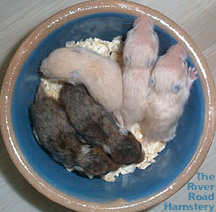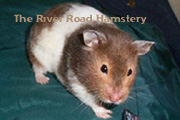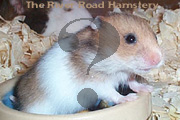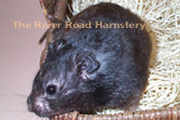
Contents
Genetics Index
The Basics
Chromosomes and
Genes
Dominant and Recessive,
Genotype and
Phenotype
Homozygous and
Heterozygous
Sex Chromosomes and
Sex Linkage
X-Inactivation
Mutation
Mutation Basics
Mutation in Syrians
Table of Mutations
Inheritance
Gametes
Punnett Square
Monohybrid Cross
Dihybrid Cross
Trihybrid Cross
Linkage
Sex Linkage
A Common
Misconception
Probability
The Nuts and Bolts
Examples
Principles of Breeding
Breeding Techniques
Dominant Traits
Recessive Traits
Epistasis
Lethality
Inadvisable Crosses
Lineal Purity v.
Heterogeneiry
Tortoiseshells and
Tricolors
Genotyping
Agouti v. Self
Basic Colors
The Golden Genotype
Combination Colors
Coat Types
Patterns
Eye Color
Ear Color
The Preliminary Genotype
Expanding the Genotype
• Parents
• Siblings
• Offspring
River Road Hamstery
(limited version)
Contact
|
Syrian Hamster Genetics: Probability
For the cross Ee x Ee we say that it is likely that 1/4 the litter will be Black Eyed Cream (ee). But how likely? How likely is it that we'd end up with no Creams? Or all? Intuitively, it seems reasonable to say that it is much more likely to get a litter that is 1/4 Creams than either all or none. What about the size of the litter? Does that make a difference? It makes sense that if you're hoping for a Cream, a larger litter would increase your chances. But how much? Putting numbers to the problem provides an exact probability. Probability is the chance that a given event will occur. First, we have to define some variables. A variable is a letter used to stand for a number that hasn't been given a value yet Let p = probability of a specified phenotype occurring in a hamster. The values for p and q can be taken right out of a Punnett square. Let's follow through with the cross, Ee x Ee, and say that we want to know what the probability is that in a litter of five there will be three Black Eyed Creams.
Of the four gamete combinations, one is Black Eyed Cream so the chance of any individual being Cream is one out of four, or 1/4. The other three are Golden, so the chance of an individual not being Black Eyed Cream is three out of four, or 3/4. For this example, p = 1/4, and Two other pieces of information for which we need to define variables are litter size and how many in the litter are the type we are looking for.
For us, n = 5, and
It is a tedious chore where mistakes are easily made, so the best way to get this number is to cheat and lift it from a ready-made chart called Pascal's triangle. (It is fairly straightforward to generate. Each value is the sum of the value directly to its left and the one to its left and one row up. ) The litter size (n) is across the top. On the left is the number of hamsters in the litter with the phenotype you're looking for (r).
Looking down column 5 (litter size in our example) and across row 3 (the number of Creams) we find 10 with a lot less aggravation. This value we are going to call a. Let a = the number of possible arrangements of the specified phenotype in the litter. a = 10 Now that we've collected the numbers, what is the answer to our original question: Given the cross Ee x Ee, what is the probability that in a litter of five there will be three Black Eyed Creams? Calling the answer to our question C, we can solve for it with a formula. C = a x pr x q(n-r) Substituting our own values we get: C = 10 x (¼)3 x (¾)(5-3) C = 10 x (¼) x(¼) x (¼) x (¾) x (¾) C = 90/1024 = .088 = 8.8% So there is just under a 9% chance that we will end up with exactly three Black Eyed Creams in a litter of five. This formula works with all similar genetics questions. Here are a few more examples. Sometimes you will get a litter where the composition strikes you as odd. Using the probability formula is a way to check it out. A recent post on one of the hamster message boards read, "All three of the Black babies in our litter of eight were male," leading to speculation that the Black gene was sex-linked. To determine the likelihood of all three being male we identify the variable values as before. p = 1/2 (the chance of a hamster being male) C = 1 x (1/2)3 x (1/2)0 C = 1/8 (Remember that any number raised to the 0 power is 1.) In a group of three hamsters, the chance of them all being male is 1/8. Putting it another way, one out of every eight three-pup litters can be expected to consist of three males. Considering the number of hamsters around, this would be a very common finding. It would be much more rare to discover a new Black gene that is transmitted as a sex-linked trait. So it is highly probable that the litter composition mentioned in the post was just a chance occurrence.
When you want to produce a hamster with a specific phenotype, it is a good idea to know what your chances are of doing so. We wanted to engineer a Banded Golden male split for Black to sire a Banded Black line. The chosen dam was a Banded Sable known to be heterozygous for Bandedness and Umbrous (BabaeeUu). To produce a Black carrier, the sire needed to be Black (aa). Our Blacks were all from a pure line. The question was whether or not there was a decent chance of getting the phenotype we wanted in the litter. First, we expand the parents' genotypes to include the pertinant loci from their mates. Remember that this doesn't change their genotypes; it only makes note of what was already present but before had no reason to be included.
Then we can write a Punnett square.
The chance of any individual in the litter being Banded Golden (shaded) is 1/4 so the chance for a Banded Golden male is 1/8. (So the chance of not getting a Banded Golden male is 1 - 1/8, or 7/8.) Not being able to predict litter size, we will assume an average litter of 8. The number of Banded Golden males we are looking for is not one, but at least 1. Instead of solving the formula 8 different times and lumping together the answers, it is much easier to figure out the probability of getting 0 Banded Golden males. Subtracting this value from 1 gives us what we want. Gathering the variable values, we have p = 1/8, q = 7/8, r = 0, n = 8 and a = 1 . C = 1 - [1 x (1/8)0 x (7/8)8] C = 1 - 0.34 C = 0.66 = 66% There is a 66% chance that at least one Banded Golden male will show up in an average size litter. It is a worthwhile mating.
There is a special case that comes up when a cross results in eight potential phenotypes, all of equal probability. This happens when, at each of three loci, one hamster is recessive and the other is heterozygous. An example is Sable carrying Cinnamon (eePpUu) x Cinnamon carrying Black Eyed Cream (Eeppuu). Another is White Bellied Satin Golden carrying Black (AaSasaWhwh) x Black (aasasawhwh). Many people who breed their hamsters would like to see the entire spectrum of colors in the litter. So, given an average sized litter of eight, what is the chance of getting every phenotype in the litter? Intuitively, it seems like there would be a pretty decent chance of getting this kind of distribution, since the probability is 1/8 for each phenotype and there are 8 in the pack. There is a simple formula for determining these chances, and it works whenever the litter size equals the number of possible phenotypes, provided they are of equal likelihood. C = n! / nn (The "!" is read "factorial" and means that you multiply the number n by the number 1 less than n, then by the number 2 less than n, and so on until you reach 1. For example, 5! = 5 x 4 x 3 x 2 x 1 = 120.) For n = 8, C = 8! / 88 C = (8 X 7 X 6 X 5 X 4 X 3 X 2 X 1) / (8 X 8 X 8 X 8 X 8 X 8 X 8 X 8) C = 0.0024 = 0.24% That translates to less than a 1 in 400 chance. Odds improve greatly for n = 4. An example of this cross is Black Eyed Ivory (eeLglg) x Golden carrying Black eyed Cream (Eelglg). The 4 phenotypes - Golden, Black Eyed Cream, Light Grey and Black Eyed Ivory - all have an equal expectation of occurring. C = 4! / 44 C = (4 X 3 X 2 X 1) / (4 X 4 X 4 X 4) C = 3/32 = 0.09 = 9% Granted, 9% is considerably better than 0.24%, but still the odds don't reflect the hope generated by intuition. Of course, with litters larger than the number of potential phenotypes, the chances increase. Formulas to figure the odds though are too complicated to bother with. |
||||||||||||||||||||||||||||||||||||||||||||||||||||||||||||||||||||||||||||||||||||||||||||||||||||||||||||||||||||||||||||||||||||||||||||||||||||||||||||||||||||||||||||||||||||||||||||||||||||||||||||||||||||||||||||||||||||||||||||||||||||||||||||||||||||||||||||||||||||||||||||||||||||||||||||||||||||||||||

No part of this website may be reproduced in any form or by any means
without the prior written consent of the owner.



